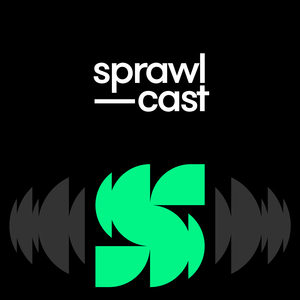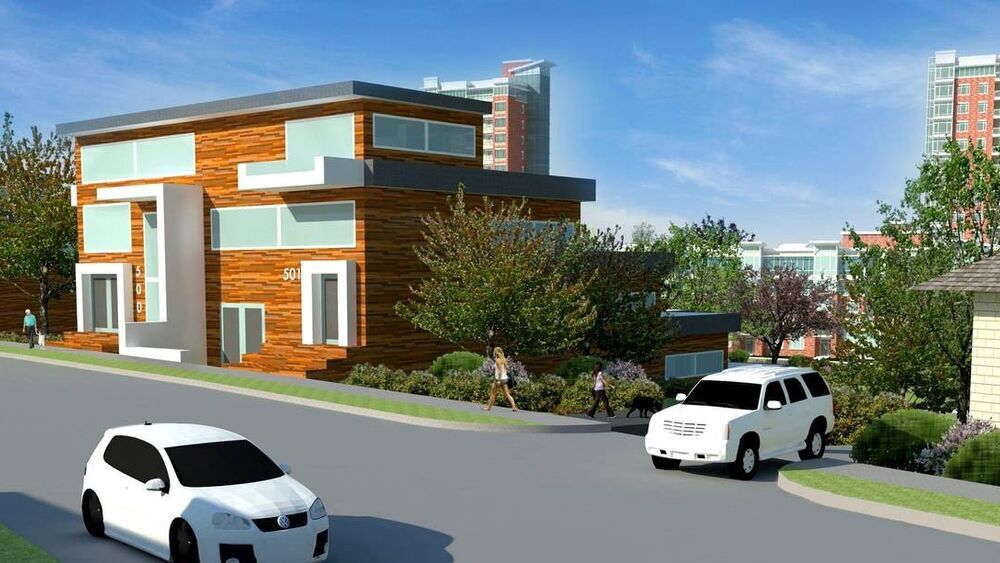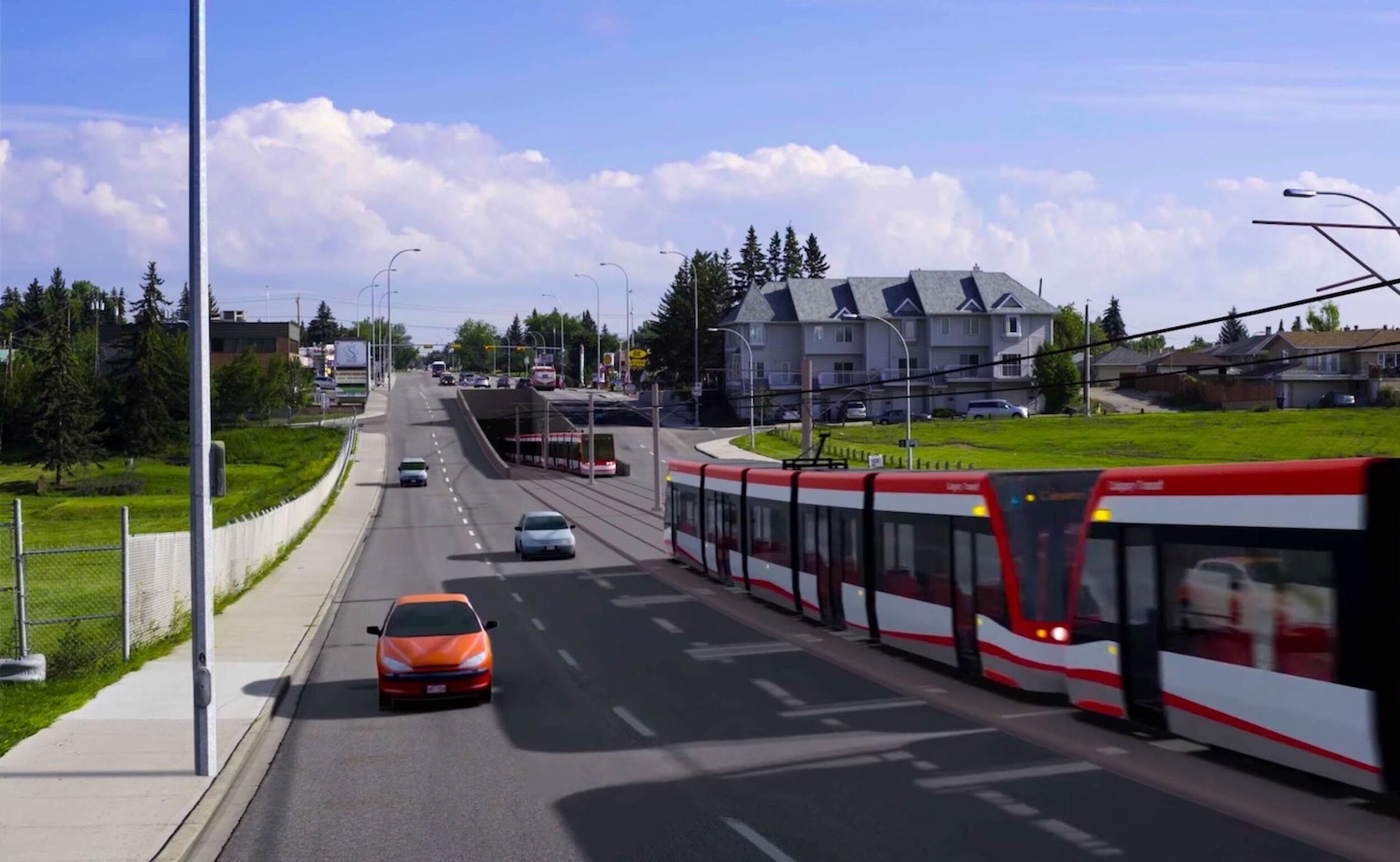
Proposed Green Line on Centre Street. (City of Calgary/YouTube)
Sprawlcast Ep 19: Green Line revisited (Part 2)
Unpacking the route’s history — and its uncertain future.
Support in-depth Calgary journalism.
Sign Me Up!We connect Calgarians with their city through in-depth, curiosity-driven journalism—but can't do this alone! We rely on our readers and listeners to fund our work. Join us by becoming a Sprawl member today!
The Green Line drama continues. Two years after city council approved the Green Line alignment, Councillor Jyoti Gondek wants to revisit it. Meanwhile Councillor Evan Woolley is calling for a pause on the project. We take a closer look at what was originally decided and why—and how new changes could affect the project, for better and worse.
A full transcript of the episode is below. You can subscribe to Sprawlcast on iTunes, Google Play or Spotify.
COUNCILLOR JYOTI GONDEK: This was never a static project. This is something that we knew would be quite dynamic, and because we haven't moved forward yet, is there an opportunity to do this in a better way that keeps up with the times?
MICHAEL THOMPSON (CITY OF CALGARY): Yeah, actually, I don't mind having the public conversation. This is Calgary's largest infrastructure project, and I think we should be having a good public discussion on it. I guess one of the pieces that's maybe being missed is that we've already had an extensive public discussion on it.
ELISE BIECHE (HIGHLAND PARK): I feel like my head is spinning with what's going on at council, if I can say that right now. Like, I actually feel completely confused.
JEREMY: Those are some civic leaders talking about the Green Line, and this is a special episode of Sprawlcast. We're going to take a little more time on this episode to go deep and really look at the Green Line: what it is, why it's going where it's slated to go, and how those things were decided – and where we go from here.
There's a lot of ground to cover, so let's get right to it. And we're actually going to do this by following the path of the Green Line from south to north. It's going to get more intense the further north we go, so be aware of that, but we're going to begin where it's a little bit quieter, where things aren't quite so contentious, and that's in southeast Calgary. This is where the first stage of construction is slated to happen.
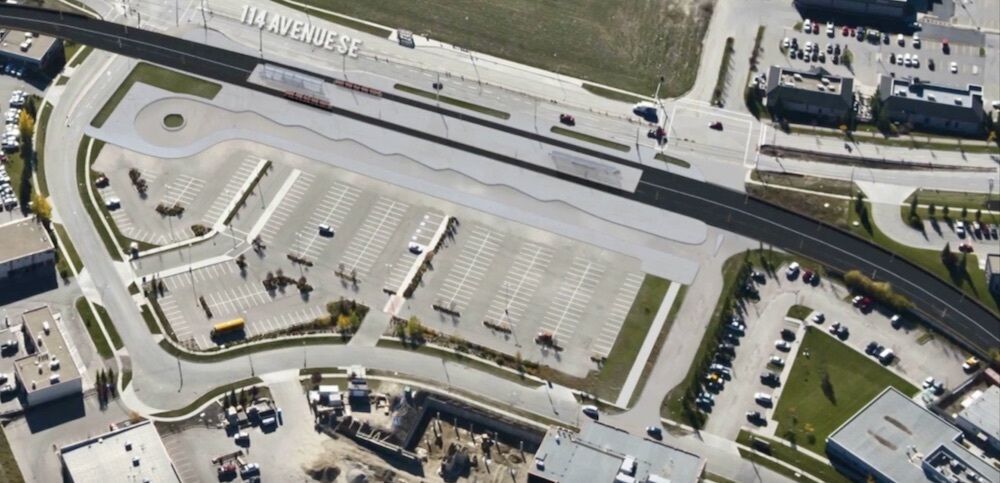
Sprawlcast Stop #1: Southeast Calgary
MICHAEL THOMPSON: We were in the midst of planning a convertible transitway for the southeast.
JEREMY: This is Michael Thompson, and he's the City's General Manager of Transportation. He's talking here about the origins of what we call the Green Line. That's what we call it now, but if you go back six or seven years, it was initially thought of as two pieces.
THOMPSON: If you remember back, council had approved $520 million, and that was to build a busway [in the southeast], which we would convert over to an LRT later on. And then we were also at the same time doing the planning for the north-central LRT. The original plan had called for the north-central LRT to run up through the Nose Creek Valley, and we'd been engaging with Calgarians, and heard back from Calgarians that that wasn't the preferred route. They really wanted a transit line that served people from the downtown through communities, and so we were in the midst of doing a planning study to move that over.
We finally selected Centre Street as the preferred alignment, and the two were coming together really in the downtown. We had the southeast SETWAY project; we had the north-central LRT being relocated from the Nose Creek Valley up through Centre Street; and they were connecting in the downtown, and we created one project connecting those two together: the Green Line.
We wanted it to be more than just a transit project.
JEREMY: And the City has been working on this with the public since 2013 – so, floating different alignments, different ways the Green Line could look and feel, and that really ramped up in 2015. That's when the Stephen Harper government committed $1.5 billion to the project.
THOMPSON: And we really worked with Calgarians in the communities to establish what the vision for the project would be – not only for what the train was, but for how it would integrate into communities, how it would operate, and really, we wanted it to be more than just a transit project. A lot of the success you've seen in these projects is how they integrate into the land use around them, how they spur development.
And so through that discussion, we came to the terms of the project that we have in front of us right now, which is stage one, from 126th Ave to 16th Ave in the north.
JEREMY: And why was it the southeast part that's being built first, as opposed to, say, doing the whole north leg first?
THOMPSON: Yeah, there was a lot of different factors that we had. One, we needed a place to have our maintenance and storage facility, so we looked at locations all the way from Aurora Business Park, which the City has some land up in Aurora Business Park. That's near 96th Ave in the north. From that location all the way through down to the south.
We finally selected the Shepard facility, because we thought it was the right-size parcel for us, near the line. We actually need a fairly large piece of land for these facilities, and we need one that's close to the LRT tracks, because you can't really have it too far away, otherwise you're spending a lot of operating dollars running the trains back and forth empty. So we found an ideal spot for us from that perspective. The south right now is underserved by transit, and so we did have a desire to get out there.
JEREMY: Another factor was that land acquisition was easier in the southeast compared to the northern leg of the project along Centre Street.
In 2013, we were talking about a dedicated bus lane for the southeast and part of the north-central.
JEREMY: And here's another factor.
COUNCILLOR SHANE KEATING: Now, more than ever, it's important to reflect on how far we have taken this project.
JEREMY: This is Councillor Shane Keating. He represents Ward 12, which is in the city's deep southeast, and he has been council's most outspoken champion for the Green Line project. He's being a relentless advocate for transit service to that part of the city – in fairness, not just to his part of the city – to the wider city as well – but he's made damn sure that that thing is going to the southeast.
Here's Keating at a council meeting in May 2017.
KEATING: When I first joined council in 2010, this project was hardly on the radar. In 2013, we were talking about a dedicated bus lane for the southeast and part of the north-central. Today, we are on the verge of breaking ground on one of the most important projects in Calgary's history.
JEREMY: That was the summer – in 2017 – that city council approved the Green Line alignment. Eventually, it's going to cross the whole city from top to bottom, but that's years off still. Right now, what they're working on is stage one, and that's slated to run from 130th Ave in the southeast, up through the downtown, and end at 16th Avenue North – at least for the time being.
In the southeast, the City has bought most of the land that they need for the Green Line there. They've been relocating utilities, and they moved two landfills out of the way. And this is the section that they're saying, let's go ahead and build now. They've run into problems downtown, but they're saying, let's go ahead and build the 16 km of LRT that runs into the southeast.
Okay, so we're going to keep heading north now, but first, I want to give you a little bit more of a sense of what this project is going to look like, because if you're picturing the CTrain, it's not going to look like the CTrain. It's going to look a little bit different.
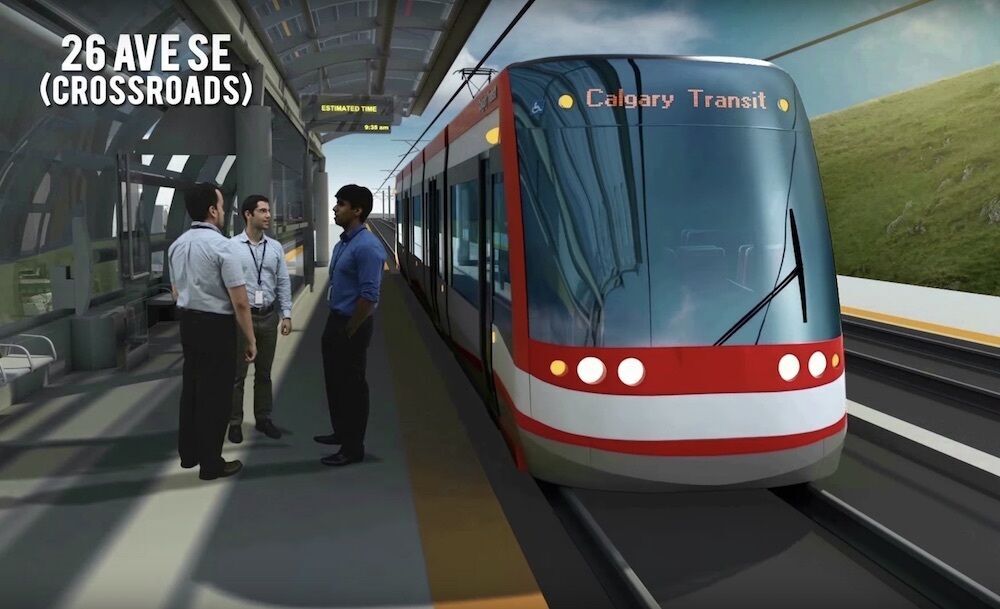
THOMPSON: The vehicles that we're moving to a low-floor LRT, they can move 80 km an hour, like our existing train lines can. At the same time, they are a lower – sorry, a shallower – vehicle, lower in height. The door is about a foot off the ground so you don't have to climb up a big platform to get into them, and so you're able to integrate them into the community a lot better. Some of the stations can be almost like a raised sidewalk with an integrated canopy into it.
JEREMY: All right, so we're leaving the southeast now, and we're heading into the Beltline and downtown, and we're going to be disappearing deep underground into a tunnel
Or will we?
Sprawlcast Stop #2: Beltline/Downtown
JIM GRAY: The Green Line is the largest and most technically challenging megastructure project, by far, that Calgary has ever attempted. We have no experience in the highly technical underground stations and tunnels of this magnitude, and no experience in the scale of this project.
JEREMY: That's retired oilman Jim Gray speaking to council's Transportation Committee in June. Gray is leading the charge for city council to put a pause on the entire project, due to the challenges of tunnelling under the downtown. You can hear more about that in the previous episode of Sprawlcast, but this is something that City admin itself has identified as a challenge.
If you go back a couple years, City admin had initially recommended tunnelling under the Bow River, under downtown, and that's the way to build the Green Line through the centre city. But last month, they came to council committee and said: No, we don't think that anymore. We should shorten the tunnel, bring as much to the surface as possible, and look at other options.
So here's the question: What changed?
THOMPSON: We originally started looking at a twin-bore tunnel, and so that was two separate tunnels about 7 m in diameter, side-by-side, that the trains would run through. And then we also looked at a single-bore, which was a larger-diameter tunnel. A machine would come through it, and we actually would have stacked the trains on top of each other in that.
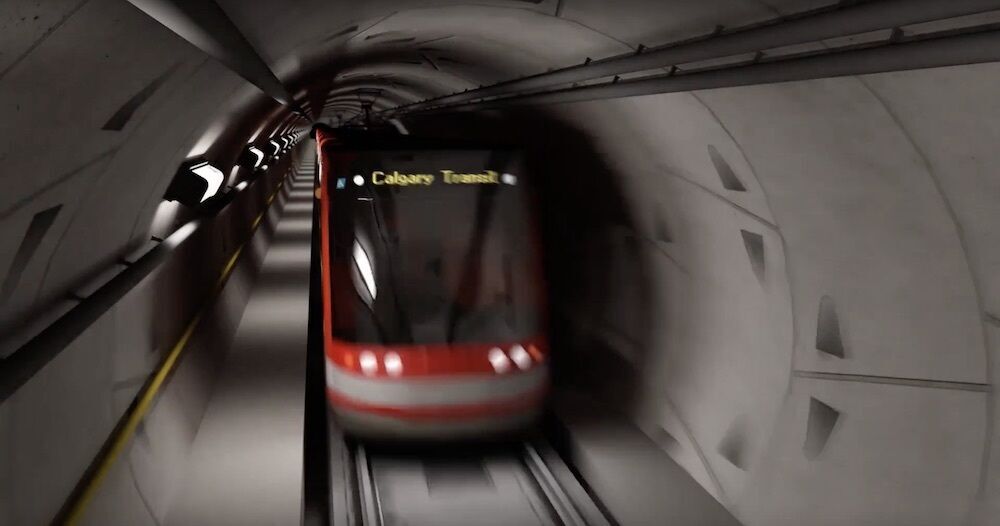
As we worked through that, the single-bore was coming out to be the preferred option from a tunneling perspective, but it was actually pushing us deeper underground. Our stations ended up being seven stories deep through the downtown. As we were looking at that, we realized it wasn't meeting the vision that we had originally established with Calgarians. We're moving to a light – or, sorry, a low-floor – LRT. Our vision has been that it's a lighter system. It integrates into the community. It really is planned for that easy accessibility, and putting people down a maze of escalators seven stories underground wasn't accomplishing that vision.
We were being driven down by a number of factors. One of them is the tiebacks from existing buildings. So when existing buildings downtown are constructed, they've got a temporary wooden wall that they build. That wooden wall is supported by some anchors going underneath the road, and so there are steel rods, steel anchors, that go underneath the road. We were having to dip down to miss all of those. Once you're already down missing those, we got a bit deeper to get into better geotechnical conditions – but again, we were seven stories down. And so we really looked at it and thought, maybe we should just come up shallower, look at a different means of construction – still going underground through the downtown, but not being seven stories deep. And so that's really what we want to come and talk to Calgarians about.
At the same time, if we were that shallower through the downtown, that could allow us to do something different across the river – like a bridge over the river instead of a tunnel underneath it – and so we wanted to talk about those options.
Our stations ended up being seven stories deep through the downtown.… we realized it wasn’t meeting the vision.
JEREMY: So at the Transportation Committee meeting in June, admin shared their concerns about tunneling, and they said, basically, this is high risk – we need to look at doing something else. And then Jim Gray's group made their pitch for pausing the entire project for a year.
Well, the following week, in early July, Councillor Evan Woolley announced that he's going to be asking council to hit pause on the Green Line at the July 22nd council meeting.
We're going to hear more now from Councillor Woolley. This is from an interview that I did with him on July 5th.
COUNCILLOR EVAN WOOLLEY: I supported this project, period, under the acknowledgment that it was going to be a true subway or a real train and not a commuter train. Remember, our whole transportation system in the city is based solely on pumping people from our outer neighbourhoods into the downtown and back out, and as a representative in Ward 8, we had seen the consequences of that, and so my constituents were saying, we need transit that works for us. And one of the biggest reflections that we have on our 7th Avenue LRT line is, man, oh man, we should have done it right the first time and put this underground.
The train system that I am committed to and willing to fight for is a train that works through the downtown, a train that creates value, and not just another commuter train. When we started to do this project, we used the word "city shaping," and that we were not going to build … right? Not that the other LRT lines don't serve us incredibly well, but this was going to be a different train. It was going to be a city shaping train.
I supported this project, period, under the acknowledgment that it was going to be a true subway or a real train — and not a commuter train.
And it's interesting, you know, we're having the conversation about a new arena, and we're arguing over whether it's an event centre or an arena – an event centre being something more for the community, and all that. We kind of don't know whether it's going to be an event centre or an arena, because we don't know what the product is and we don't know what the programming is. And it's one of the concerns that I've had over the train, is we've just been – we've been calling it city shaping, and we talked about it, but the city shaping component has fallen off quietly over the last year. We don't have land use planning around stations. We're uncertain about TOD – transit-oriented development – community planning around these stations, how people are going to get in and out of them … That has fallen off the map, in a lot of ways. We've dropped the ball on that.
And likewise, the real turning point for me was in November of last year, when 30% – so, they brought... Calgary Planning Commission with our citizen members – and they brought 30% design through CPC. And when I saw that, myself and a couple of other Planning Commission members said, "Good god, this is not a city shaping train."
JEREMY: When you say 30% design, what does that mean?
WOOLLEY: So it is, like, high-level designs – here's kind of how this thing is going to run, and that's confidential for a number of reasons, but I can tell you that I became increasingly worried at that CPC meeting, and I know that one of the citizen members leaned over and said, "Good god, what are we building?"
And so this has culminated in my motion, which is seeking for us to just tap the brakes and get some eyes on this. It's easy for you to say … It's funny, I posted this online, and social media is coming out and saying I don't support public transit. You can't just – right? It's a very … It's not a clear-cut thing, right? But it plays itself out, "Do you support transit or do you not support transit?" Right?
This is much, much more important and much more nuanced than that, because we can build a train, for sure. We can build a big, crappy train that goes from a train maintenance facility in Shepard, runs up through all of our industrial areas and through a couple of neighbourhoods – Ogden, where I grew up – and comes through Inglewood, and then just pounds itself through the downtown in the cheapest, fastest, worst way possible.
And that's what I'm concerned is happening: We are cost engineering out the most valuable pieces of this train line and the most important pieces of this train line.
JEREMY: So why not take the approach of, hey, it's all hands on deck. We need this now – like, let's get moving on this. Why the approach of pausing it, as opposed to, hey, here was the plan, let's stick with this?
WOOLLEY: The pausing is pausing one piece of work and moving very, very quickly on the other pieces of work. We're not talking about pausing the construction of the train. I am asking for a pause button. I don't want to put out a request for proposals, an RFP, to contractors to start a part of the train without knowing what the rest of the train is looking like. And what our administration is asking us to do is to split them into two separate contracts – one being, start running down the path of the south portion, and take time – they've asked for more time to understand the downtown portion.
The pause button is on the south part of the train. I do not want to put shovels in the ground without having figured out that piece first.
And you know what? The economics and the financial operating of this train have shifted, and so the risks that we have if we don't take a really thoughtful look at this now is not only do we have a train that has a bad product, that doesn't create value, that doesn't connect people in the downtown core, that kind of goes to nowhere; but if we build that train, it also won't have a financially viable operating model. And I don't want to burden future councils and Calgarians with operating costs of a product that they don't even want.
The economics and the financial operating of this train have shifted.
JEREMY: So how does Jim Gray and his group fit into this? They've been meeting with the Green Line team. They've been meeting with some councillors … Did they meet with you?
WOOLLEY: You know what? I have never met with them on this project. And listen – they nailed a couple of things. They're concerned about the ridership model. They're concerned about how this thing is going to go through the downtown.
The difference between us is, one of their suggestions is to put it elevated across East Village, which is a terrible idea. Nobody's building elevated trains through the city. This train must go underground – and potentially further than it does now. And so there's a big difference.
But I have not met with this group of people. I know Mr. Gray and Mr. Felesky. They are wonderfully committed Calgarians. They are concerned about the risks associated with this project – and people should be. But their solution of potentially putting this train elevated through Victoria Park, I mean, is not something I could support.
JEREMY: One of the concerns that I saw yesterday that people have is about this project as a whole. So we've seen the emergence of this narrative that, you know, "Why are we even building the Green Line? This is a boondoggle" – all this sort of stuff. And so pressing pause, even if it's to get downtown right, does that put the larger project at risk? Like, do you lose momentum? Do you end up revisiting all this stuff that was … You know, all this consultation, all this work that was done – is that at risk? Because that seems like a legitimate concern at this point.
WOOLLEY: Yeah, you know what? I am not interested in building a project that sucks and doesn't serve Calgarians, so I would rather not do the Green Line, than do a crappy Green Line. And so just building whatever transit – just saying, "I want to build more transit," in what is a very complex system to run is something we need to be thoughtful of.
And here's the other thing: We should be able to ask tough questions throughout. And what's happened – and I'll even admit some of that – is that we've just started to be like, "The Green Line is going forward," and you get the engineers on the project, and we're building a Green Line, and we get really path dependent, and it's been a while since we've said – right? We should always be pausing and reflecting, consistently – especially on a $5 billion project that will have such an incredible impact on our city and our neighborhoods. So we haven't stopped to just do a gut check in a while.
I would rather not do the Green Line than do a crappy Green Line.
JEREMY: We are about two years since the last election. It's about two years until the next one. Mayor Nenshi has hinted – has been quite obvious he's not running again. Are you planning on running for mayor in 2021?
WOOLLEY: You know, I am super focused on my job right now, and my family. I've got an 11-month-old at home, and we have significant challenges today before us that I'm really focused on – namely, the financial position that we found ourselves in, and a whole number of projects that we're faced with. And so that's not a decision that I have made or given much thought to, but I have been incredibly privileged to serve my constituents in this job, and I'm looking forward to doing that in the next couple years.
JEREMY: And what would you say – because to many, it does look like a capitulation to press pause on this, to cater to the people who see these kinds of project as a waste of money: "Why are we building this in the first place?" What's your response to that?
WOOLLEY: The Beltline Neighbourhoods Association came out earlier this week saying: Whoa. Wait a minute. We're worried about how the station is going to impact our neighborhood.
And so if by capitulating, you mean capitulating to the concerns that are raised by my constituents – absolutely. If that means … If I'm worried – and I am worried – about how people living on 17th Avenue in and around whatever that station – the owners of Hotel Arts, all the restaurants and businesses, Village Ice Cream, all of those wonderful … If what I'm hearing from them is concern about how this train is coming through my neighborhood, and I'm capitulating to those concerns – absolutely.
JEREMY: All right. Thanks, Councillor.
WOOLLEY: Thanks very much.
Sprawlcast Stop #3: City Hall (circa 2017)
JEREMY: Our journey continues, but before we leave the downtown, we're going to stop in at City Hall. And we're going to go back in time – two years – to June 2017, when council's Transportation and Transit Committee approved the final Green Line alignment. Now, keep in mind, this is the previous city council. This isn't the current one, although a lot of people are the same. I think it's important to go back and listen to this, especially as people are proposing moving the Green Line's alignment, and we're coming into that part of the story.
But first, let's listen in.
FABIOLA MACINTYRE: On behalf of administration, I'm very pleased to present the Green Line LRT long-term vision, from 160th Avenue to Seton.
JEREMY: This is Fabiola MacIntyre, and up until earlier this month, she was the Deputy Director of the Green Line project. She suddenly resigned, and that's been a blow to the Green Line team. I've heard her described as the heart and soul of this project. She's really been driving it for years now, and she gave a sense of continuity while there's been turnover on the leadership of this project over the past couple years, and so her departure is a significant one.
Anyways, let's listen in to what she had to say.
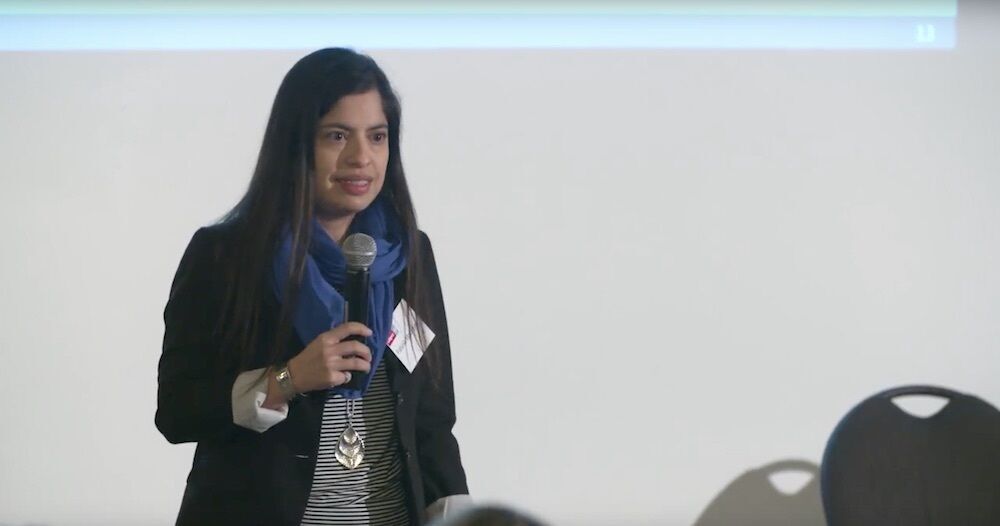
MACINTYRE: Since 2013, administration has been engaging with transit customers, communities, and numerous other stakeholders, to help determine the placement of the alignment, how to best access the stations, how the infrastructure can become the catalyst or support development, and to connect Calgarians to the destinations and to activate the many public spaces along the corridor.
Over 10,000 participants have provided input and had a say in today's final recommendation. Today's recommendation, and the finalization of the long-term vision for the corridor, has considered the communities of today and thought through their evolution with the Green Line as part of them in the future.
JEREMY: This was an interesting meeting, because you had different people and groups expressing support for the Green Line alignment for different reasons. You had some of the usual suspects there – urbanists like the LRT on the Green Foundation, which had been pushing hard for the project.
Here's Jeff Binks with that group.
JEFF BINKS: The Foundation believes that the final Green Line vision delivers the best overall value and the maximum level of benefit possible to Calgarians and deserves the full support of council.
JEREMY: But you also had institutions like the Calgary Stampede saying, hey, we support this too. The Stampede was excited because one of the initial plans had been to run the train at grade on 12th Avenue, and they didn't like that at all.
ROY WRIGHT: And the Stampede at that time raised its concerns that it could not handle another barrier similar to what the Red Line has created on the Stampede's western boundary.
JEREMY: This is Roy Wright, and he was speaking on behalf of the Stampede.
WRIGHT: The Stampede position was that vehicle traffic must be allowed to continue unencumbered on 12th Avenue, plus retaining the north-south access points.
JEREMY: The Stampede was happy because the God-given and inalienable right of Calgarians to drive their cars to Stampede had been protected.
WRIGHT: The Stampede CEO, Warren Connell, would like to have been here today, but he's out of town on business, but he did ask me to share one statement:
"The Stampede applauds the efforts that the administration has undertaken to ensure the Green Line is functional, integrated into the community, and maintains affordability for the taxpayer. Future generations of Calgarians will believe city council made the appropriate decision in supporting the proposed realignment along 10th Avenue."
The Stampede was happy because the God-given right of Calgarians to drive their cars to Stampede had been protected.
JEREMY: Councillors also heard from the building industry. This is Richard Morden, who was speaking on behalf of the Building Owners and Managers Association, or BOMA Calgary.
RICHARD MORDEN: Together we represent building owners, property managers, landholders, and much of the commercial and residential real estate industry throughout Calgary. We are very pleased to stand before you today and support the vision and alignment for the proposed Green Line as presented by staff today, and by vision, we mean the entire line as contemplated from Seton in the south to 160th Avenue in the north.
We believe that notwithstanding the understandable need to phase construction of this critical project to manage the funding constraints, the integrated planning approach behind visioning the entire line as one project represents a huge stride forward relative to the phased planning approach taken for the Red and the Blue lines and ensures a much better Green Line in the end.
MORDEN: This integrated full-vision approach allows future transit-oriented developments and is focused on the stations to be identified along the line, and interconnecting transit infrastructure and other community amenities can be planned to fit with this vision and this alignment, and required land can be acquired to facilitate faster realization of the total vision.
JEREMY: Morden also talked about the importance of the line going underground in the downtown.
MORDEN: You will all recall multiple presentations by the real estate industry over the last couple of years highlighting potential negative effects of building the downtown and Beltline portions of this line on the surface or at elevated configuration, including negative impacts on assessed values and taxes collected from all real estate, including office, retail, restaurants, and other businesses along the way.
The recommendations clearly put forward a better long-term vision for the Green Line: building it right the first time.
MORDEN: We also noted the potential impact on retailers and restaurants of reduced daylight; sunlight; increased noise pollution; and potentially, increased opportunity for crime; arising from raised alignments.
We also noted out the negative potential of surface or surfacing alignments to split communities like Chinatown and Eau Claire, and communities in the Beltline and Vic Park, reducing the potential of these areas to become vibrant, successful, complete communities, including new residential populations and associated retail and amenities.
We also noted the potential future significant cost to correct these poorly built transit alignments in the future. As other large cities such as New York have done – and Toronto – we'll have to start to do.
It's for all these reasons that we applaud the final vision of Green Line as presented today. The recommendations clearly put forward a better long-term vision for the Green Line: building it right the first time.
JENNIFER BLACK: Good morning, members of council. So I'm here speaking today on behalf of the Crescent Heights Community Association. So just a quick summary of what I'm going to be speaking about today – and to preface my presentation a little bit, I wanted to say that we fully support Green Line. We're very excited by the project. We've seen the great work done by staff, and so we're really excited to be a part of it.
We fully support Green Line. We’re very excited by the project.
JEREMY: This is Jennifer Black, and she talked about her community's hopes for what the Centre Street alignment could do for that street.
BLACK: Centre Street is not vibrant. Businesses are suffering due to low foot traffic, because it's not a pleasant place to walk right now, and so we hope to see increased foot traffic through measures such as wider sidewalks, more public amenities like bike racks and public seating, trash receptacles, street trees, and so we hope as part of the Green Line project, and potentially as part of the Main Streets project, to see some of these improvements come to Centre Street.
JEREMY: And now we get to the sore point, which is that stage one is only running as far north as 16th Avenue, and a lot of people in the north part of the city aren't happy about that. Why is it stopping at 16th Avenue? Why is it going southeast instead of north?
Here's what Councillor Druh Farrell said at that meeting.
COUNCILLOR DRUH FARRELL: I don't see this as us stopping there. I see this as just a first phase. And if you look at the history of transit in Calgary, and the LRT, we didn't stop with the little tiny area that we did with the first phase of the Red Line or the Blue Line. We just kept marching on. And what I find most gratifying is the commitment to public transit, which is the first time that I've really seen that. It's a generational shift for the city of Calgary. So there's a commitment to invest in transit. I don't see us stopping at 16th, and I'm sure we won't. We'll continue going forward, and the planning work is already done.
VOICE: Yes.
FARRELL: So it will be easy. We don't have to debate the alignment again and again like we've done before. The work is done, and we'll be ready to go.
JEREMY: So that's where things stood in the summer of 2017: City council approved the full alignment, including the Centre Street portion. And so it was settled.
We don’t have to debate the alignment again and again like we’ve done before. The work is done, and we’ll be ready to go.
JEREMY: We're going to keep going north up the Green Line route, but first, I need to give you a little bit of background information about where we're headed. And to do that, we need to go back to 2012.
Up until 2012, the City planned to build a north-central LRT line along Deerfoot Trail and Nose Creek. The City owned much of the land for the right-of-way. There's not much that's really built there that you'd have to work around, and in short, it would be easy to build, and you could connect the communities of north-central Calgary north of Beddington Trail with the downtown.
The problem was, of course, nobody lives along Deerfoot Trail. And so the City decided, this doesn't make any sense. There's no people living down here. Why would we build a train line where there are no people?
And so in 2012, they started looking at other options – namely, Edmonton Trail and Centre Street.
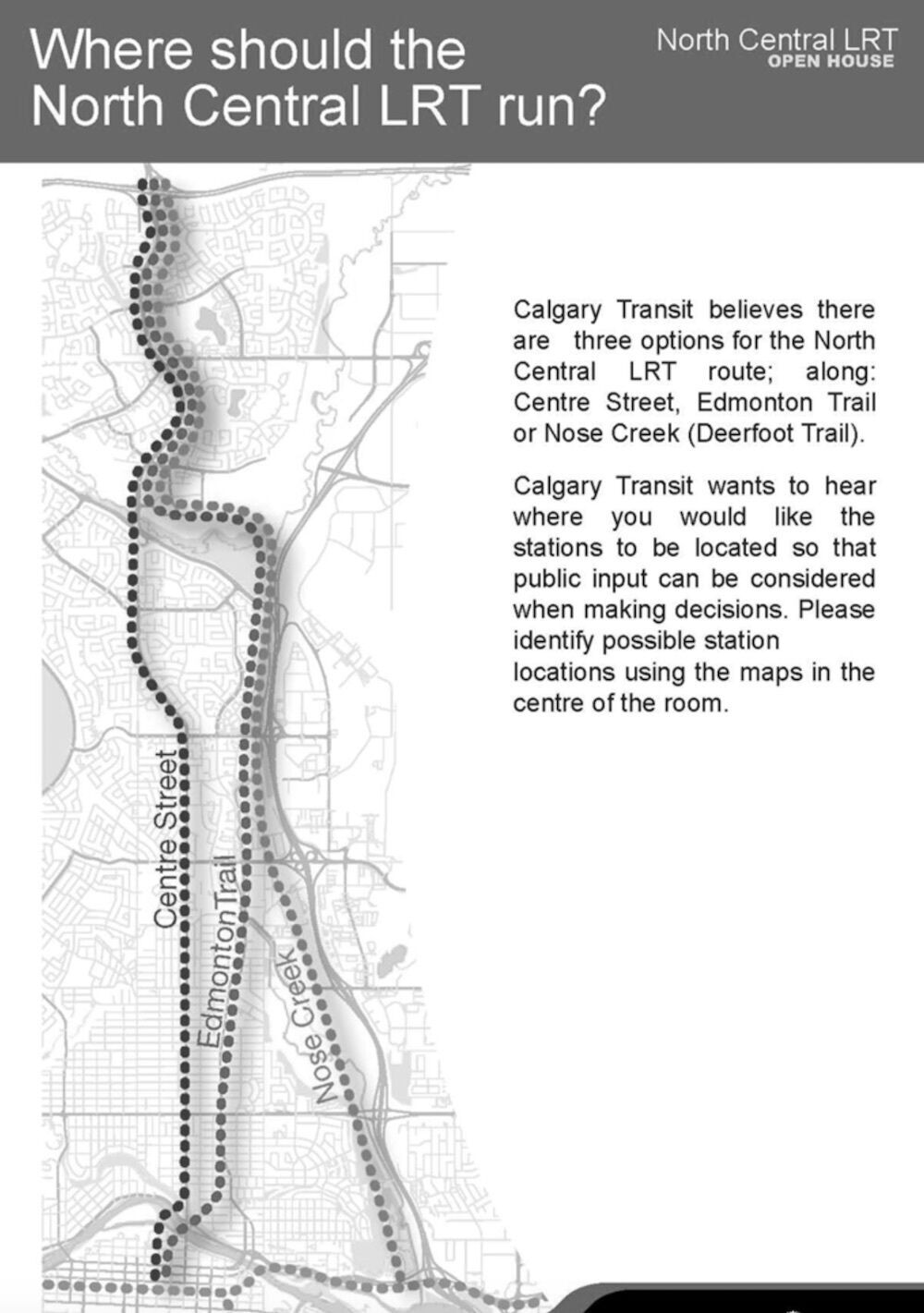
JEREMY: In 2014, City Hall decided on Centre Street.
Here's Michael Thompson with the City again.
THOMPSON: The original plan had called for the north-central LRT to run up through the Nose Creek Valley, and we'd been engaging with Calgarians and heard back from Calgarians that that wasn't the preferred route. They really wanted a transit line that served people from the downtown through communities.
FURTHER READING: Goodbye North Central LRT (FFWD Weekly, April 2012)
JEREMY: And so everybody has been working with the Centre Street alignment for five years – since 2014. But now that's being revisited by politicians in north-central Calgary.
The push for a pause on the Green Line, and Councillor Woolley's Notice of Motion, have had a bit of a domino effect here.
Councillor Jyoti Gondek and Conservative MP Michelle Rempel are both floating the idea of putting Nose Creek back on the table as a way to get transit sooner to the communities that they represent, because it's going to be a long wait with the Centre Street alignment. The City needs to expropriate hundreds of properties – they haven't started on that yet – and they don't have funding for that expropriation.
We're going to hear from Councillor Gondek in a bit, but first we're going to go north on Centre Street, where communities have been getting ready for the Green Line for years now.
Sprawlcast Stop #4: Highland Park (Centre Street)
JEREMY: So I'm here with Elise Bieche, President of Highland Park Community Association. Hi, Elise.
ELISE BIECHE: Hi, Jeremy. Good to see you again.
JEREMY: Good to see you too. Here we are standing at the intersection of 40th Ave and Centre Street, and what are we looking at here – this patch of land?
BIECHE: Yeah, we're looking at an empty lot. It has been purchased by the City of Calgary, and the land has been allocated to the – hopefully – future site of the 40th Avenue train stop along the Green Line.

JEREMY: This has been something you guys have been working on for years. So let's go back a few years to when you guys presented at council together with some neighboring community associations. And what was the message you brought to council?
BIECHE: Yeah, so we went down to Transportation and Transit Committee – oh, my goodness, was that 2014? Could've been. I don't even remember now. I feel like it was so long ago.
And we really brought the message that the three communities here in the centre part – or, in the north-central part – of Centre Street were in favour of the Centre Street corridor as the alignment for the Green Line. From a planning perspective, we really wanted to see this as the impetus for rejuvenation of the corridor and bringing investment into our communities and all of the good things that come with billion-dollar, kind of, capital construction.
JEREMY: Yeah.
BIECHE: It's not playing out that way. [laughs] Or, I don't know how it's playing out.
From a planning perspective, we really wanted to see this as the impetus for rejuvenation of the corridor.
JEREMY: So then 2017 rolls around, and the City says, okay, well, we're actually not going to build this part right away. We're going to do stage one up to 16th Avenue.
What was your reaction when that decision was made?
BIECHE: That's a great question, and I think we were really disappointed. So in 2017, what was happening was a lot of uncertainty, which threw redevelopment, kind of, to the wayside. So what was city council going to do if they were only going to define phase one? And, you know, phase two was kind of nebulous. We really started to see a slowdown in applications and a slowdown in the redevelopment of the corridor, and a lot of uncertainty and, kind of, disappointment, because council had given the approval on the golf course, and that was supposed to be a transit-oriented development, but then we were being told, well, you're going to be transit oriented, but not yet.
JEREMY: Just a note here. She's referring to the former Highland Park golf course, where a controversial development – mixed-use and high density – was supposed to go. And you can learn all about that in the first-ever episode of Sprawlcast. It was our first episode.
Anyways, back to the interview.
BIECHE: I feel like my head is spinning with what's going on at council, if I can say that right now. Like, I actually feel completely confused. If council was so set on this being a corridor, and, you know, we were approving the golf course, and, you know – and, honestly, we were, in the last, I would say, six to nine months, seeing a new level of applications coming into planning, and we were seeing exactly what council had hoped – was, you know, making this a vibrant corridor, making this an activity centre, and the land use applications were really headed in that direction, and I think – and I'm fearful that this talk at council is going to change developments and developers' perspective on the viability of the corridor.
And honestly, I just kind of wish that they would, like, just make up their mind. Like, how often do we have to do this as a community? We've been on the tipping point for well over 10 years. We've been recognized as a neighbourhood of promise. Let's move on from that. Let's start to invest in what does it take to densify our inner-city communities and bring all of those things together – and that includes transit, and that includes the Green Line, in my mind. But I'm shocked – I'm just shocked.
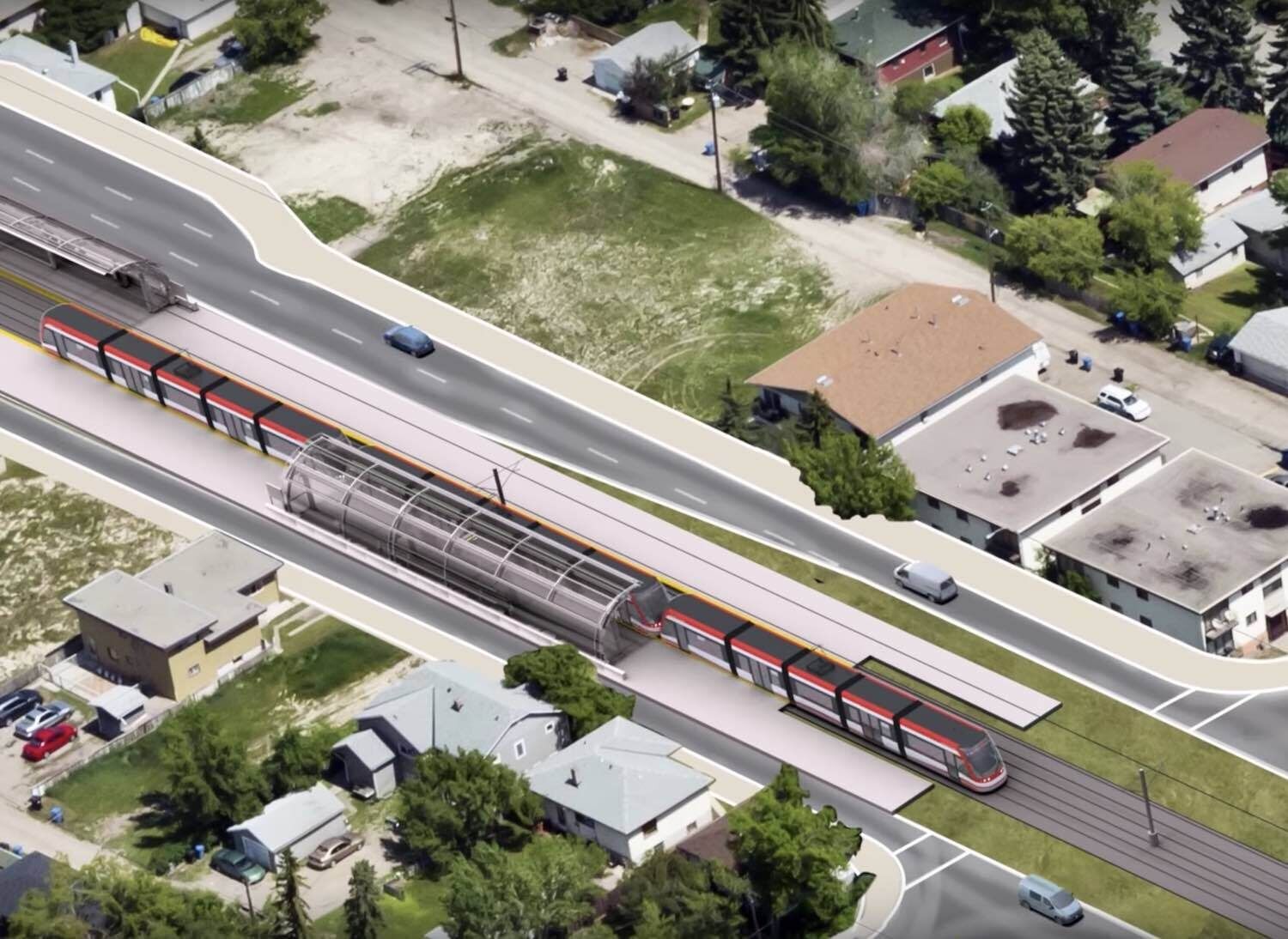
JEREMY: And you mentioned the land use applications you're seeing now. Can you describe those a little bit more in terms of the quality you're seeing? And also, is that tied to the Green Line coming?
BIECHE: Yeah, absolutely. So the planning department has been very purposeful in ensuring that applications that are coming before them that have property that is facing Centre Street are really making sure that that ground-level is going to be vibrant and it's going to be active. The applications for – specifically for this site right behind you, Jeremy, which used to be the Centre Street Church, is going to be the Wing Kei site, and their phased approach and facing Centre Street is all about inactivity – you know, creating commercial on the main level and then multi-use at the height.
One block down from here, that entire block is being redesignated MU [mixed-use], so that's a great sign that developers are looking at this and saying, oh, we can restore this corridor. We can bring this back to life.
JEREMY: And what would it mean if that opportunity didn't happen? So let's say it did get built along Nose Creek and this did not happen along Centre Street. What would it mean to the community?
BIECHE: I think that there are many in the community that would be incredibly disappointed in this council. You know, this council – or, I guess, the previous council – gave an approval on the former golf course site – and I know I'm going to say that dirty word – based on that being a transit-oriented development and really was driving density.
I think that there are many in the community that would be incredibly disappointed in this council.
I think it would be a shame to try and drive density without all of the necessary improvements and infrastructure that it required, and I think the community would be disappointed. We would be asking, how do you want us to serve the people that you want to live in this community? If you want us to double our density or more in the next 20 or so years, how are we going to make that happen? What's the impetus for people moving into the inner city?
JEREMY: Yeah. And my last question – council is meeting about this on Monday – what are you hoping to see come out of that meeting?
BIECHE: I don't know if I say it politely on your show [laughs], but I would say, like, shit or get off the pot. Really, like, you know, you can't use it as a tool sometimes or a leverage point sometimes and then pull back from it. That's unfair to the residents. It's unfair to the development committee. It's unfair to the Municipal Development Plan and to everybody in administration who's trying to meet certain goals.
So I would just say, like, maybe what's done is done, and you guys got to live with it, and you figure out a way to make it work.
I would say [to city council]: shit or get off the pot… You can’t use it as a leverage point sometimes and then pull back from it.
JEREMY: Is there anything else you would add that I haven't asked, or that's missing in this conversation that …
BIECHE: How did this happen? How did this happen? [laughs] You have to answer – you have to answer that for us all. Like, I'm just – I'm gobsmacked.
JEREMY: Yeah. Because this is years – years of work, right?
BIECHE: Years of work. I mean, more community engagement on this file than I have – genuine community engagement, too – than I've ever seen, and I'm just shocked that they would think that they should just throw that away and potentially start with a new alignment. This was supposed to be a city shaping project. A city shaping project. Not a commuter train, not a bullet train, not, you know … This was really supposed to help the city achieve so many goals.
JEREMY: Well, we'll see what happens on Monday.
BIECHE: I don't know if I should stream it from my office, or if I should go down. Either way, I'll be pulling my hair out. [laughs]
JEREMY: Yeah. [laughs] Well, thanks for your time.
BIECHE: Thank you so much.
Sprawlcast Stop #5: North-Central Calgary (Ward 3)
JEREMY: All right, it's time now for our final stop. We're going to keep going north, north of Beddington Trail, into Ward 3. Now, before we go into Ward 3, I've got to warn you: If you bring up transit to somebody in Ward 3, get ready for an earful. And if you want to know why, just look at a map of the city's rapid transit network: You've got branches going to the northeast, northwest, southeast, southwest. What you don't have is a line going north. There's a giant dead zone on the map.
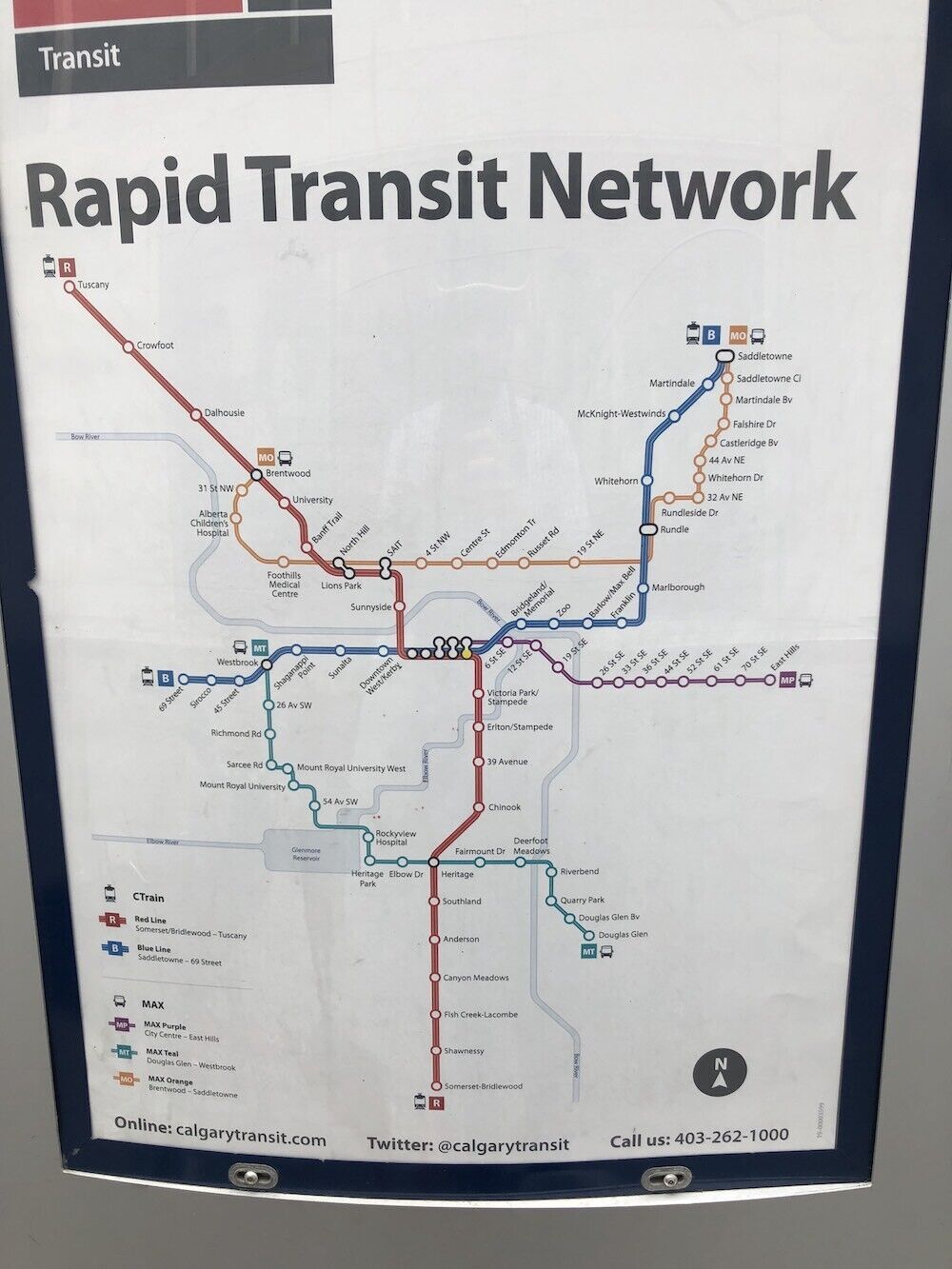
At the start of this show, I talked about how the southeast has a transit champion in Councillor Shane Keating. And here's the plain truth of it: The north has not had that champion. In fact, in 2017, when City Hall rolled out stage one and it was clear that the train would not be going north right away, the former Ward 3 councillor, Jim Stevenson, said, "Ah, it's fine," basically. He told the Calgary Herald, "There's not going to be rioting in the north." He said the people in the north would be excited about it, because it means the project is under way.
Well, the current councillor sees it very differently.
We're going to hear now from Councillor Jyoti Gondek, and I began our interview by asking why she wants to revisit the northern alignment of the Green Line.
COUNCILLOR JYOTI GONDEK: I have said for a very long time that I don't agree with the decision that the previous council made to go south before going north. I continue to stand by that. As a matter of fact, when I read the proposed prioritization criteria that are coming up in the Route Ahead plan, it just solidifies for me that it should have gone north. If we ran the Green Line project through that prioritization process now, the plan would be to go north.
So it frustrates me to no end that the 73,000 people who live in Ward 3, who have a full right-of-way and the ability to build a track, will not ever see that happen because the Centre Street alignment right now is unfunded to acquire the properties from 16th up to Beddington Trail, where my communities actually start. So it's frustrating. And if that's the case – if we're not going to be able to do the Centre Street alignment because no one put funds aside for land acquisition – then am I going to sacrifice multiple generations of Ward 3 residents ever being able to access rapid transit, or do we start looking at other options?
I’m tired of everyone in my ward having to wait for pieces of infrastructure because they are a north-central ward.
That's why I want to do a rethink, and that's also why I don't think it's too late for council to reconsider the movement south. I mean, I know we're ready to go with a request for proposal, and I have said, as much as it hurts me to do it, I'll support at least starting something so we can eventually move north. But if starting something in the wrong manner is what's before us, then maybe we need to rethink why it's not going north.
JEREMY: So how do you square that, which I think is understandable – like, as you've said, look at a transit map and you see branches going every which way except north-central Calgary. So how do you square what you're saying with modern planning principles with transit-oriented development – all that stuff?
GONDEK: It's hard to square that. But the fact of the matter is, if the City is looking to acquire land along Centre Street to do TOD, and we've never actually done any kind of transit-oriented development as a city effectively – we've tried a couple of times and they haven't been able to follow through on it – I have no confidence that not having the money to purchase the land and not having the track record in doing TOD is going to get us anywhere on Centre Street. So my primary concern becomes moving the people in Ward 3 in a manner that lets them get to work in a way that's other than a packed 301 bus that they've got to wait two or three times to get onto.
So I don't know that I can reconcile it with good planning principles – I can't. But we forgot about moving people when we thought about good planning principles. We created this wonderful, idealistic vision, but we forgot that if you don't fund it, it'll never happen, and you've got generations of people not having mobility options.
I don’t know that I can reconcile it with good planning principles — I can’t. But we forgot about moving people.
JEREMY: So just to be clear, are you suggesting the Nose Creek alignment, or are you looking at, say, Edmonton Trail, or what are you suggesting as an alternative?
GONDEK: I want to find out, when the decision was made to do the Centre Street alignment, what the next-best options were. And I know they're out there, and I know a lot of people were in the sessions where they were discussed, and there's a lot of people who have said to me, "Oh, my God, this has been done before. Why do you want to rehash this?" I want to rehash it because we forgot that we need to move 73,000 people out of Ward 3 into the places they need to go, and without any kind of a rapid transit option, we're not providing them a service that they deserve to have. So now I've been thinking about, do we combine some sort of a rail line east of Centre Street with a BRT route – more like a MAX route – along Centre Street. Is that the least disruptive way to move people in all of the communities south of Beddington as well as those that are north of it?
So I don't have all of the answers, but I certainly want to explore it before we tie ourselves to something that we can't change.
JEREMY: And how does the City, or city council, keep this from becoming – I'm trying to think of the phrase – regional squabbling, I suppose. Like, you've got Councillor Shane Keating in the southeast has the advantage over you in the sense that he's been able to champion this for years on council, and now that alignment and that plan is very much in that part of the city's favour. Councillor Woolley has said, you know, let's pause in order to get the downtown right. He's got concerns about downtown. You've got concerns about Ward 3. In between downtown and Ward 3, the people in Thorncliffe and Highland Park value that Centre Street alignment, even though they see it a long way off, but they're already seeing some development around there.
So how does this project unfold as a … as a city, I suppose, and not just as each regional piece?
GONDEK: That's a really good question, and for the people that have said to me, you know, you need to fall in line with decisions that were made, if I feel those are the wrong decisions and there are residents that are going to suffer for it, I can't be quiet about it. I will not apologize for fighting for the Centre Street alignment to take priority. That north alignment should absolutely take priority.
That north alignment should absolutely take priority. Maybe what we should have done, which we still can do, is offer the BRT route to the southeast.
And maybe what we should have done, which we still can do, is offer the BRT route to the southeast. That's their modal progression. That's what should have happened. The modal progression for the north has always been, and continues to be, LRT. So maybe that's the rethink, and maybe that's the shift: Let's do proper mode.
JEREMY: So what was the turning point for you in the last couple weeks? Because at committee last month, you said kind of what you said before, which is, this is a bitter pill to swallow in terms of the southeast going ahead, but hey, let's do it. What changed that now you're saying, let's look at the alignment of this project?
GONDEK: I think what's changed for me is the number of people that are willing to press pause and examine different components of it. And if we're willing to do that and we're going to go out and find private-sector partners that may have some innovative ideas that we haven't yet considered or things that are fairly new since the last time we looked at this, and we could actually deliver a proper line, a longer line – one that really serves the residents well – if we're pressing pause, we might as well look at the whole thing. It can't just be a pause on the little pieces that people think are easiest for them.
To your point, why are we pressing pause on the bits that we think we can get away with? If we actually looked at the project in its entirety and we were able to explain to the provincial and federal governments that we would put their money to better use and get them to back it, I would love to see that. My fear right now is that we'll lose the money if we pause – if we look like we're indecisive. I don't want to do that, and that was why I was willing to swallow that bitter pill. But I also have a feeling that if we're able to talk to our provincial and federal partners and say, "Look, we really feel that there's a better solution, and it can happen in this way. Just let us do the qualification process a little bit longer," I think we might be okay.
JEREMY: And how optimistic are you about that? Because observing this council, I'm not terribly optimistic about that kind of thing happening without it being quite messy, and then the concern is the whole project is at risk, at a certain point.
GONDEK: I think the whole project is at a bit of a risk right now. I don't want to appear like we're being indecisive. We absolutely have to deliver the Green Line. It's a project that is sorely needed in the city. If we want to move forward with our plans to grow as a competitive global city, we need to have a Green Line.
Is it time to reconsider some of the decisions we made around staging and modal progression? Maybe. If we are looking at the RFP and RFQ process a little bit differently, then I'm going to open it up to say my communities got ripped off in the first place, and I want that back on the table. And no, it won't be pretty.
I think what’s changed for me is the number of people that are willing to press pause and examine different components.
JEREMY: Okay, here's one of my big questions watching this whole thing – and forgive the transit pun – but who's driving the bus here? Because the mayor has not been particularly involved on this file and the recent flareups. And yeah, you've got various councillors kind of trying to do their own thing for their own areas. So in terms of public trust and – yeah, just public buy-in to this thing. Like, who's leading this at this point?
GONDEK: I'm not too sure who's leading it at this point. I mean, I would probably default to saying that the answer for most members of council would be: A decision was made; let's move on. I've said that myself. But at a time when we're rethinking the risk that's involved in the downtown tunneling when we're looking at the geology of our city and we're looking at a very, very different real estate landscape than we were, I think it's important to make sure that we're making the right decisions at the point to which this project has evolved.
This was never a static project. This is something that we knew would be quite dynamic, and because we haven't moved forward yet, is there an opportunity to do this in a better way that keeps up with the times? I think the times within which we live now are so different. That's what should be driving our decision-making – not a decision that was made previously when the world has changed around it.
JEREMY: And how does the economic situation and the changing times – how does that affect the Green Line? Because when I think about it, should it affect alignment? I don't know that it should. Like, why does the changing economy affect this project when we're looking at something that won't be completed for – well, the way it is on paper right now in your area – for many, many years? So why is that?
GONDEK: I think there's a couple of things you need to consider. Employment is considerably more precarious than it was in the past. People are trying to live on less, and if that means that you've got a two-vehicle household that's now down to one, or you've got more kids that are having to start work at an earlier age or support themselves through school, they need proper transit options.
You cannot have an entire segment of the population without a rapid transit alternative.
GONDEK: The other thing is, too, I mean, the lay of the land right now is the more productive you can be, the more valuable you are to an employer. So if you've got 30 minutes of time to be reviewing your notes for a meeting or to be reading the news or doing whatever it is that helps you be more productive at work, I can't deny my residents that opportunity. Why should they be forced to be stuck in a car when other people are enjoying rapid transit options that are not available to them? So when you look at their lives and the way they get about their everyday routine, it's absolutely critical that we provide them with the same options that every other part of the city has. I think that's why it's important.
The conversation has gotten very heated, and I've taken a lot of remarks from people that say, "I can't believe you of all people wouldn't look at this city shaping opportunity. I can't believe that you're willing to sacrifice the middle part of Centre Street just to get your residents what they need. I can't believe you're not considering the fact that a train along the Nose Creek alignment doesn't make any sense."
I am absolutely considering all of those things, but I also have to let people know that you cannot have an entire segment of the population without a rapid transit alternative, and if it means chunking things out and doing them differently, than maybe we need to do that.
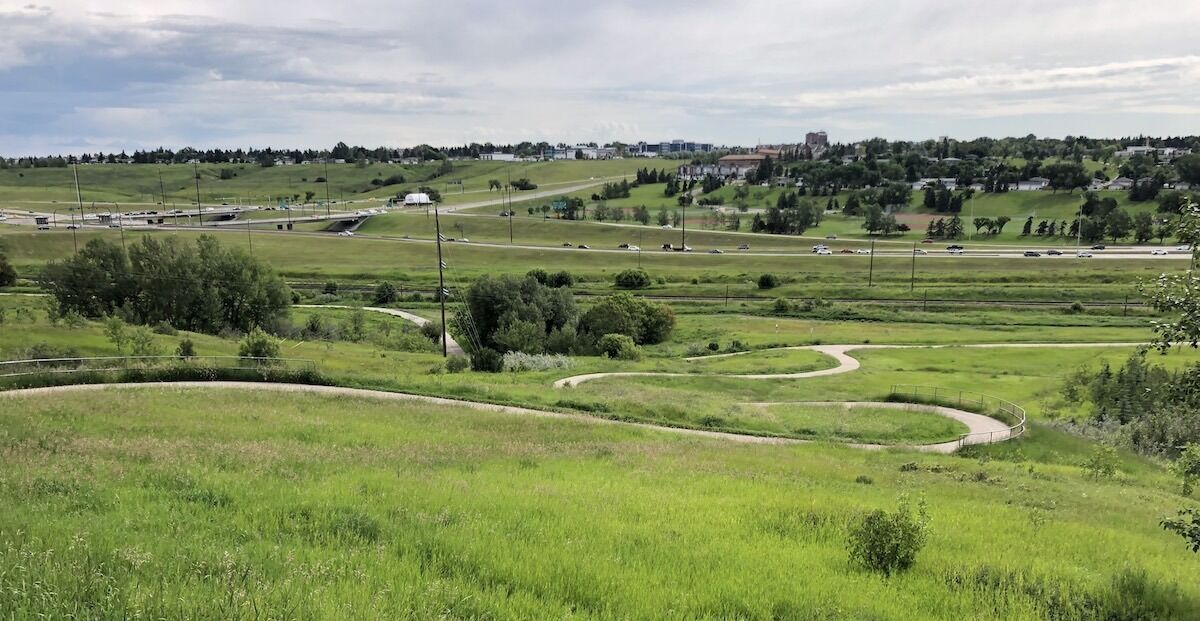
GONDEK: I mean, as recently as an hour ago, I had a conversation with our transportation team and said, "Why on earth would you put another boulevard along Centre Street, along Livingston and Carrington, when you have the opportunity to put a BRT route? Why wouldn't we do that?" And I'm not getting great answers. So I'm going to keep pushing to make sure that we are not creating more and more communities with limited mobility options when we haven't delivered on promises to our established communities.
And I think that's the thing that I find most painful about all of this: People think that periphery communities are brand-new and they don't deserve infrastructure because they're too new. These communities have been around for 30 or 40 years, in some cases, and they haven't even gotten their first tranche of infrastructure that was needed, so we can't compare them to communities in the core that are waiting for redevelopment and to have crumbling pieces of infrastructure replaced. Both are competing for the same pool of money, but both have very real needs. This is not about prioritizing one over the other.
JEREMY: So why not stick with Centre Street? It'll take a bit longer, but when we look back, you know, 40, 50 years, that'll be regarded as a good decision, whereas Nose Creek, it'll be, "Why is that there, exactly?" Like, is it not possible to wait that bit more time, whatever that is?
GONDEK: It's always easy to ask people to wait, and it's also very difficult to be the one that's waiting. And when you've got generations of people – and I kid you not, it's generations of people who have been waiting for that train line, and you ask them to wait for a couple more generations? I can't abide by that. I don't have a public high school, so our high school kids take public transit to get to their schools. Has anyone stopped to consider that? Not so much.
So I'm tired of everyone in my ward having to wait for pieces of infrastructure because they are a north-central ward. The northeast and the northwest benefits from infrastructure because they're considered a quadrant.
We've been left behind, and something needs to change.
[SPRAWLCAST THEME]
JEREMY: You've been listening to Sprawlcast – to an unusually long Sprawlcast. Usually we keep it to 30 minutes, but I wanted to give this one the time and the depth that it deserves before this goes to council on Monday, July 22nd.
Stay tuned to The Sprawl, because we're going to keep covering this Green Line story as it unfolds.
Special thanks to Sarah Lawrynuik for helping with this episode, digging up some of the archival city council audio. And you can check out some of Sarah's other work she's been doing for The Sprawl's Climate Action Edition. Read her story on how the insurance industry is pushing cities like Calgary to take climate action. You can find that on our website.
Our CTrain theme music, which felt particularly appropriate for this episode, is by Dan D'Agostino and Kenny Murdoch, and our CTrain narrator is Holly McConnell, who is the voice of the CTrain for many years, so that's also kind of cool to have her voice on this episode. Thanks, Holly.
Thanks so much for listening, and stay tuned to The Sprawl for more!
Support in-depth Calgary journalism.
Sign Me Up!We connect Calgarians with their city through in-depth, curiosity-driven journalism—but can't do this alone! We rely on our readers and listeners to fund our work. Join us by becoming a Sprawl member today!
